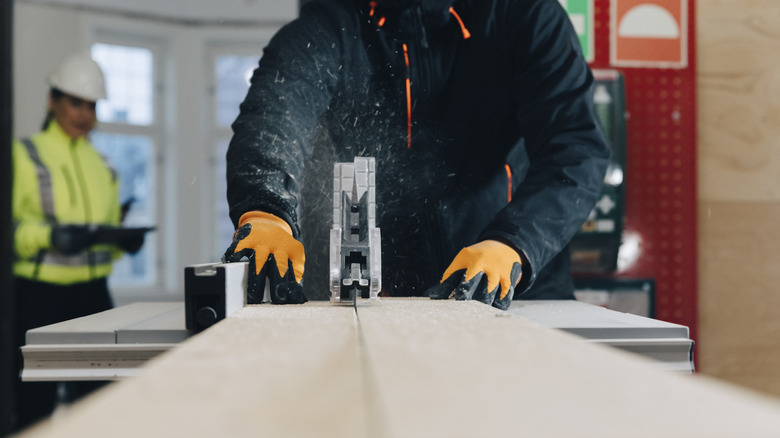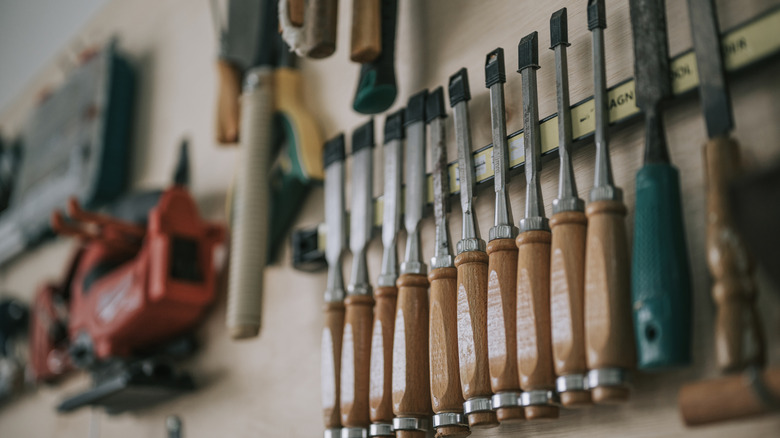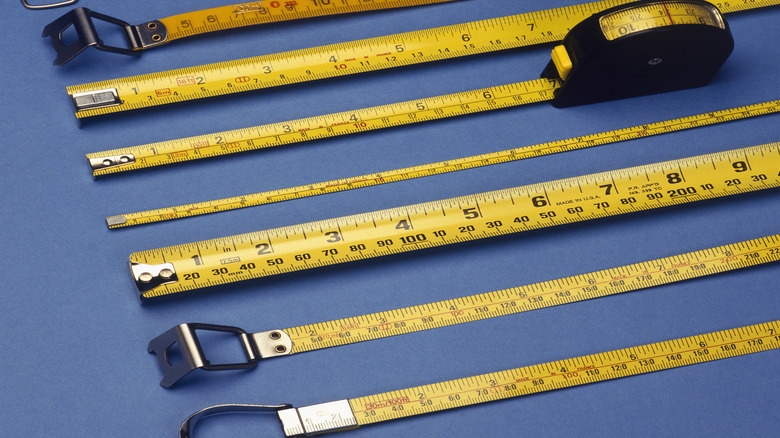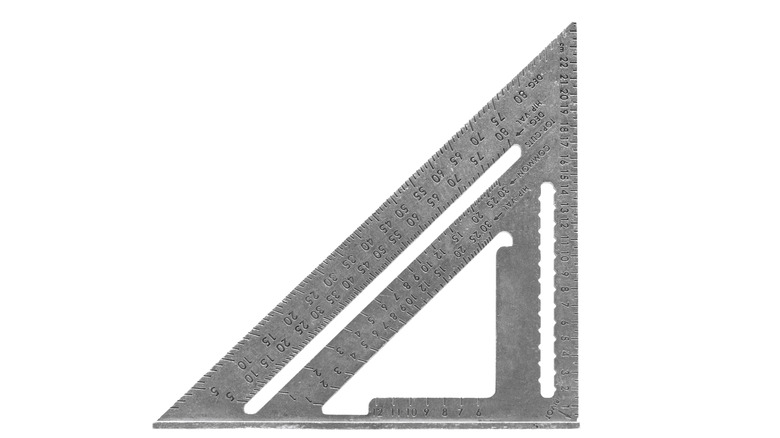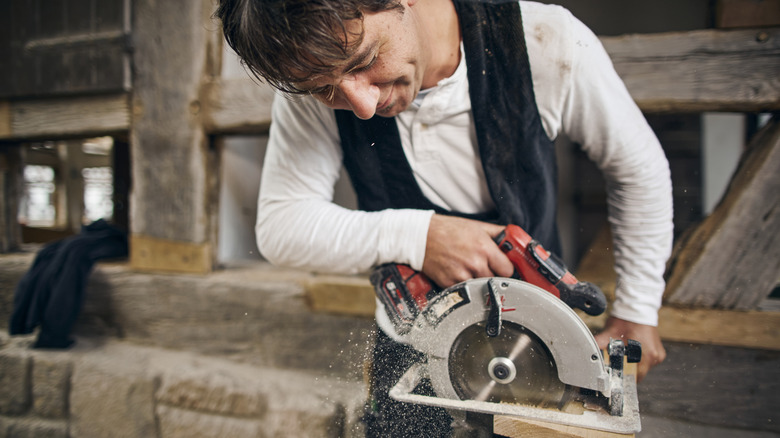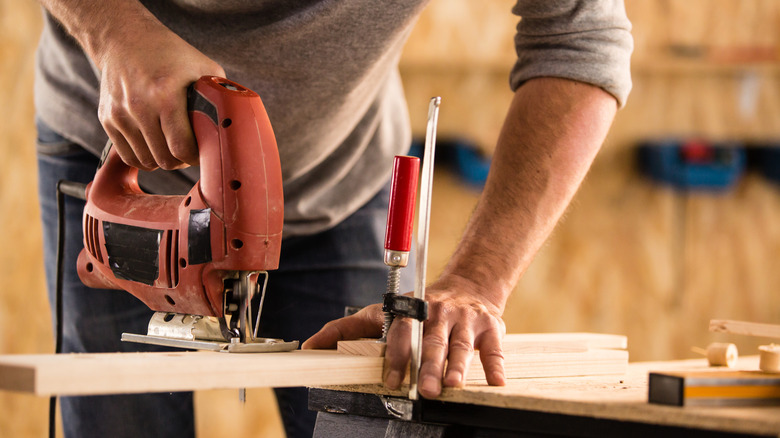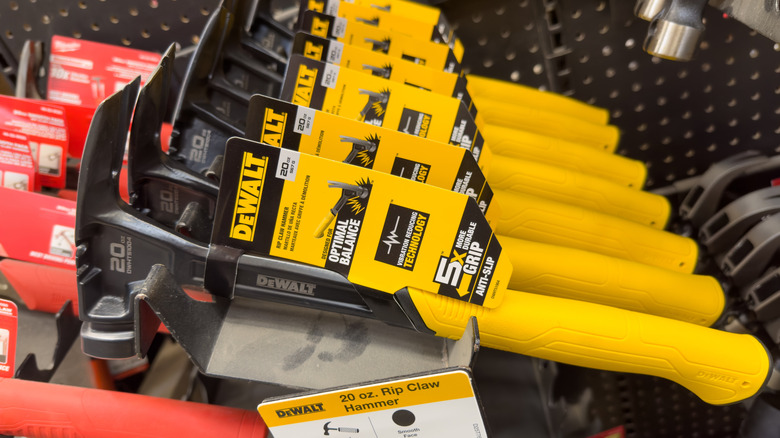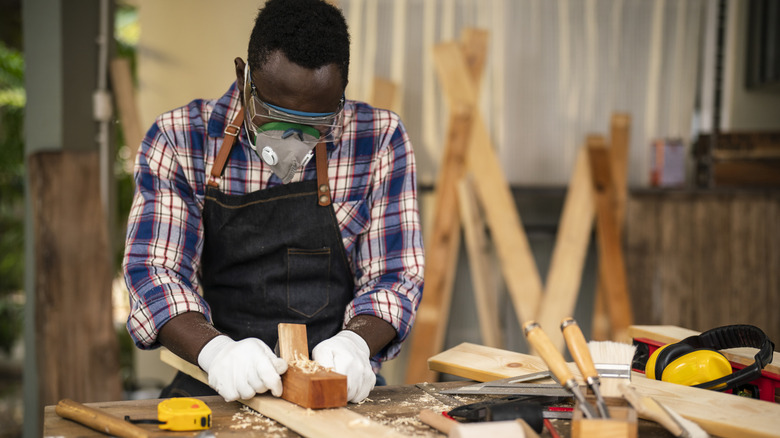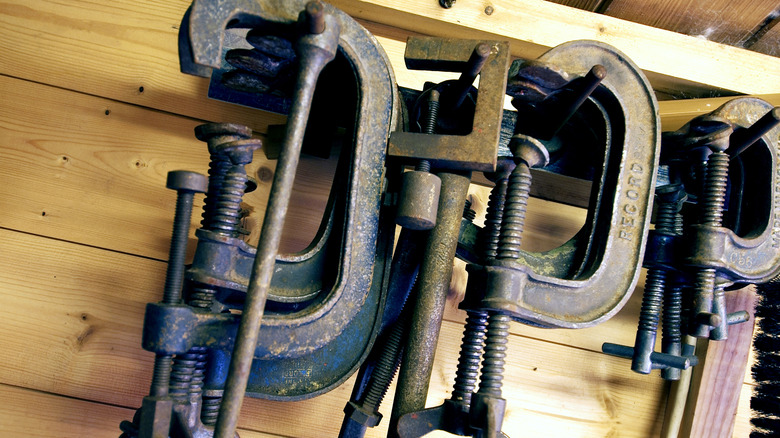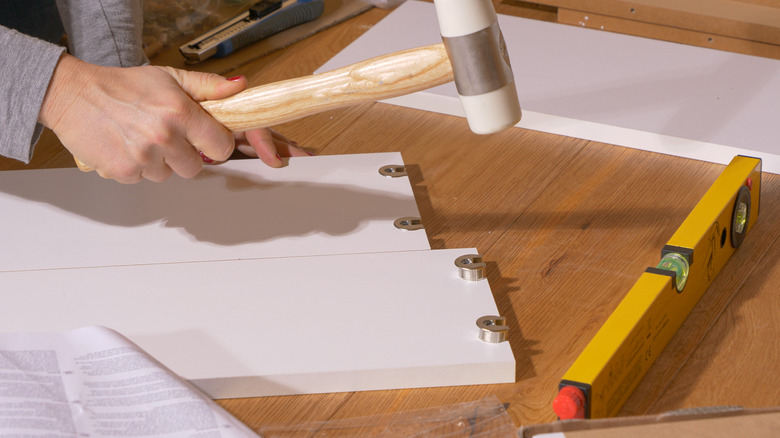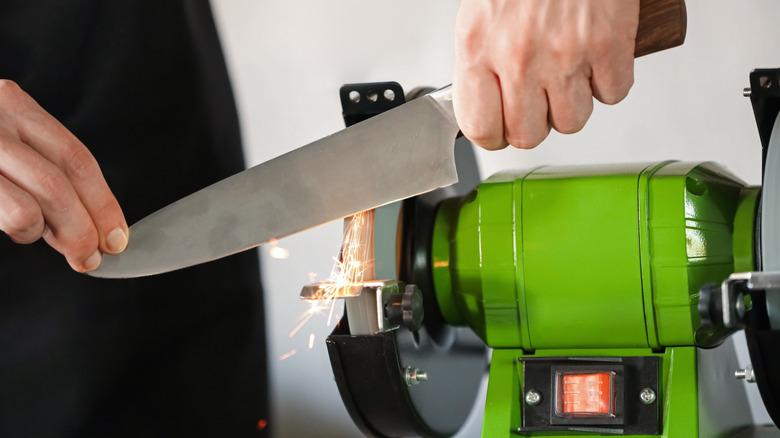13 Woodworking Tools That Are Essential For Home Renovation
We may receive a commission on purchases made from links.
Refreshing the place you call home can take on many different forms, yet the tasks of a modern home renovation often share the same goal regardless of the specific project or set of improvements. In modern DIY, just about anything can be improved upon without the help of a professional (and their frequently excessive price tags). Of course, turning to a pro for support when you get in over your head with foundation work, electrical problems, or a plumbing conundrum you can't seem to solve can be essential. Yet, many projects don't need the addition of contractor expertise. Almost anything you could seek to learn about performing a home upgrade can be found online today. YouTubers, bloggers, and everything in between serve as teachers and mentors in your quest for lifestyle upgrades. Plenty of excellent YouTube channels are great for learning the craft of woodworking, and numerous car repair channels exist out there to help home mechanics grow their toolbox of skills.
Many home improvement projects grow as extensions of the woodworking craft. Homes across America are typically built with timber framing, making renovating a property a wood-heavy task, as it is a primary material. Plenty of small woodworking projects are an ideal way to grow your DIY chops, and as you expand your knowledge, you'll certainly begin to add more tools to the garage, too. But every journey starts with a single step, and these 13 woodworking tools stand out as some of the most important implements in establishing a foundation for growth.
Table saw
The table saw is a great starting point when considering the pantheon of critical woodworking tools. A table saw is a stationary tool, much like a miter saw. Where other tools offer a single layer of functionality, the table saw provides a kaleidoscope of use cases and capabilities. Some users have even gone as far as to cut rounded bowl-type shapes into work pieces on a table saw. Though representative of the tool's versatility, this can be dangerous. A table saw can realistically replace the miter saw in your workshop, and then some. This makes it an ideal tool for all kinds of cutting, and one that's particularly useful for those working in small spaces.
A table saw allows you to cut boards on the short side and down the long dimension. With such a wide range of coverage areas, it's a natural choice to bring into any renovator's arsenal. A few high-quality options include the Milwaukee M18 Fuel Table Saw, the Portable Ridgid Pro Jobsite Table Saw, and the venerable Compact Sawstop Table Saw. Renovators seeking to stick within a singular brand platform to maintain just one battery type might consider Milwaukee first. As a part of its M18 Fuel range, this cutting tool benefits from several performance enhancements over the standard Milwaukee experience.
Chisel set
Chisels are instrumental in making precision cuts in all sorts of wooden workpieces and other materials. There is a healthy variance among types of chisels, including solutions like cold chisels or even slicks (essentially giant chisels that are pushed rather than struck). But the average renovator will often want to start with the standard chisel experience. Even here, you'll find a rich debate with yourself when approaching any particular job, considering that each new chiseling solution is ideally built for its own set of niche requirements.
Fitting new doors, working around crown molding or skirting boards, or even tackling a lofty built-in project to introduce something new to your entertainment space or bedroom will often require the support of one or more chisels to perform the finish carpentry tasks. A solid option for tackling a broad spectrum of job requirements is the DeWalt 3-Piece Side Chisel Set. The package features ¾-inch, 1-inch, and 1-1/4-inch chisels, and each one provides both a standard edge alongside a serrated component and a bladed edge on one side. The opposite side is bulky and flat, allowing you to strike it when necessary. The handle is ergonomic and comfortable, and the tool is rounded out and includes a striking cap on the end. I've personally used the 1-inch tool many times for both construction tasks and demolition operations.
Tape measures
Tape measures feature in literally everything you'll do as a renovator. There's no getting around the need to measure and mark workpieces. Whether you're building a very small decorative accessory or a massive expansion project that will substantially alter the framework of your home, measurement tools are integral to success. Unfortunately, tape measures also have a tendency to walk away. Because they are used so frequently people often find that they put down a tape measure somewhere and then move on off to work elsewhere. Renovators with some experience under their belts will likely find that working with more than one tape measure helps keep things moving in the right direction on a more consistent basis. With two or more tape measures on the go throughout your project, you won't have to hunt for that elusive precision measurement solution when you really need it. This is the same logic that suggests keeping a heap of carpentry pencils on hand.
The Stanley 25-Foot and 16-Foot Value Pack is a quality option in this regard. The tape measures are from the Stanley FatMax line and feature a true zero end hook as well as a mylar polyester film and armor coating to extend the life of the tool significantly. Each tape measure features an 11-foot standout rating, as well. To round things out, these tools are made in the United States, giving users yet another reason to put their faith in these Stanley measurement tools.
Speed square
The speed square might not seem like an exciting addition to your shop or garage. The tool is a basic steel or aluminum triangle that's often laid out in a 7-inch dimension. The speed square is littered with markings and cut-out segments, but it really doesn't call attention to itself. Yet what the speed square lacks in charisma, it makes up for in extreme utility.
The Swanson Two Pack features a 7-inch speed square and a 12-inch variant. Each one is made from durable aluminum to provide longevity and a lightweight frame that doesn't feel bulky or difficult to manipulate. This is important because one of the key use cases for a speed square is in marking lengthy cut lines on boards. At the bottom of one side, you'll find a lip that allows you to drag the square along a board's edge. Paired up with the holes in its geometry, users can draw a straight line at particular length intervals all the way along the board without interruption. Alternatively, this lip and the speed square's precision angle allow for quick and efficient marking at premeasured spaces on a workpiece. One final area where the speed square excels is in laying out roof rafters and other angled building elements.
Circular saw
Every renovator needs more than one way to cut boards. A stationary solution is important to have on hand, but sometimes you'll need to bring the tool to the workpiece instead. When cutting overhangs off decking or roofing elements, or even simply as a quick grab-and-go option rather than resetting your miter or table saw, the circular saw is another versatile woodworking must. Circular saws deliver significant power, even in midrange units. They are ideal for a diverse set of needs, and with such a central position in the collections of just about every tool user imaginable, you'll find an option worth considering among circular saws from every major brand.
Two standout solutions that deserve a mention here are the Makita 18V LXT Circular Saw and the DeWalt 20V Max Saw. Both feature brushless motors and a 6-1/2-inch blade compatibility. DeWalt's offering provides a Lightweight design and tool-free bevel lever to adjust from zero to 50 degrees. The tool also includes a bright LED light to help improve coding accuracy. There's also a rafter hook to improve its use on the move.
Jigsaw
Jigsaws produce curves that can't be replicated by saws that feature classic, rotating blades around a central arbor. Instead, the jigsaw features a reciprocating blade action and a straight saw blade that hooks into the tool body at a 90-degree angle. The result is a tool that can be carefully maneuvered around arcing cuts and even inserted into the middle of a board after drilling out a pilot hole of sorts to provide access. A jigsaw is necessary for renovators in supporting rough cut operations ahead of installation tasks, as well as in finish trim work across all manner of project types.
Two solid choices are the DeWalt 20V Max Keyless Jigsaw and the Craftsman 20V Keyless Jigsaw. Both feature variable speed control and keyless blade changes that make swapping out dulled cutting implements far easier. Both are cordless models, so the option you select will be heavily reliant on the tool platform of your choice in this context.
Levels in a range of sizes
Across the spectrum of home improvement jobs, a few things remain constant. Regardless of the project, the need to install components the right way is ever-present. In many instances, this means installing perpendicular to the ground at true level. Whether you're putting up shelves or repairing the subfloor, setting your components level with the ground is a critical first step.
Leveling planks or pipes can be done in a few ways. Many renovators will use laser levels in their installation tasks as a fast and effective means to strike a line. But as you go about the final touches, you'll want to use a spirit level or some other variety of physical implements to verify your measurements and marks. The Workpro Torpedo 3-Piece Level Set is a great option in this regard. With three sizes in your arsenal, you'll be able to support large-scale installations as well as slimmed-down components. Small levels are necessary to tackle discrete tasks, while lengthy tools make a name for themselves when tackling shelf installations or curtain rod positioning.
A sander
No toolbox is complete without a sander. If you're working with wood, drywall, and many other mediums, sanding is a core part of the job. Sanding parts is one of the interim tasks you'll find with many building projects, and it also functions as a key step in the final stages of applying finish to boards. Choosing the right sander for a particular job can be challenging. But it's tough to go wrong with a random orbit sander. The DeWalt 3-Amp Corded option is a great tool that does away with the hassle of burning through battery power with the sander's constant-run necessity.
If you're looking for a cordless option, the Ryobi One+ 18V Random Orbit Sander can be a big winner. Ryobi is frequently found as a major contingent in DIY renovators' toolboxes. Ryobi delivers a nice blend of cost-effectiveness and functional tool value that makes it a solid choice for plenty of users. Both of these tools deliver variable speed control and a hook-and-loop system that makes it easy to attach sanding discs.
Rip claw hammer
The rip claw hammer tends to feature as a primary solution among framers and other professionals. Unlike the typical claw hammer that many will be accustomed to using, rip claw hammers feature a straight claw that juts out from the center of the head without the classic curvature. The result is a hammer with a slightly better striking balance, at least in my opinion. It also changes the way you'll tackle nail removal when flipping the hammer over to actually utilize the claw. This tool won't damage the surface of a workpiece as much as a curved alternative.
Stiletto is among the gold standard framing hammer producers that deliver this geometry, but they are painfully expensive, especially for casual renovators who won't break out the tool very often. A great solution that blends long-term durability with high-quality features and striking performance is the Estwing Hammer. You can find them in a range of weights, but a 16-ouncer is a solid middle ground.
Hand plane and block plane
Planing is a task that seems niche at first. But the more you use a hand plane the more you realize that it's an integral component in producing just about any kind of finished product that utilizes wood as its base. As you install shelves, change doors and frame components, or build custom furniture, planing down the faces of your workpieces helps dial in the minute measurements to achieve a perfect fit.
There are lots of options to consider when thinking about hand planes, but a good starting point is the Spear & Jackson No. 4 Smoothing Plane. This provides a pattern similar to the iconic Stanley No. 4, a tool highly capable of both precision cuts and substantial flattening. To go along with your hand plane, a smaller cutting tool like the Stanley Bailey Low Angle Block Plane is an ideal solution for knocking off edges and getting into tight recesses to finish off flattening tasks along smaller sides.
Clamps
Clamping things is yet another unavoidable reality in a renovator's workflow. Clamping a makeshift rip fence in place to help support straight cuts with a circular saw or securing boards during a glue-up fall under two completely different categories of usage, but both require the help of a clamping tool. Woodworking clamps come in a range of sizes and styles, but they all support the same basic goal. A solid option is the Irwin Quick-Grip One Handed Clamp Set, giving you quality clamping versatility in a cost-effective package. Irwin is one of the best hand tool brands on the market, and these clamps will help get the job done without any fuss or hassle.
The ability to secure your workpiece as you plane one of its faces or drill pilot holes ahead of installing hardware is a fundamental one. Those without clamps will have to secure boards with their other hand or a different body part, like an elbow or knee. This introduces the potential for injury to your back or otherwise, and it's far more dangerous to contort your body while using power tools than the alternative. Clamps make things easier, safer, and reduce the risk of injury all at once.
Deadblow hammer and rubber mallet
Beyond the classic hammer that you use to support driving nails, other striking tools that fall under specialist categories help round out a toolbox. If you need to strike metal components, for instance, a mallet of some variety that isn't made of metal is necessary to prevent damage. The same can be said for other delicate materials like glass, plastic, or even rubber.
Two options occupy critical positions within the renovator's toolbox. A deadblow hammer is a specialist striking solution that features a rubber construction and hollow interior. The Pittsburgh 2-Pound Deadblow Hammer is a great choice that provides a low-cost option with more than enough striking force and durability. Deadblow hammers are constructed with heavy steel shot within the interior cavity. The result is an energy transfer profile that stops the hammer in its tracks when it strikes an object. This dissipates the strike force and prevents the hammer from rebounding in the way that a typical steel head would behave. It is a unique hammer that can be used to deliver precise strikes on things like car parts and other sensitive components. If delicate isn't necessary but a soft striking face is, a classic rubber mallet like the Estwing Double Face solution is a great choice. This provides soft and hard striking caps that are ideal for hitting all sorts of workpieces in situations where a metal hammer isn't the right choice.
Sharpening accessories or a bench grinder
Bladed instruments like chisels, screwdrivers, and plane irons need to be sharpened on a fairly consistent basis. Depending on how often you use the tools, this may be at wide intervals or on a more aggressive schedule. Either way, sharpening stones deliver a classic hand-sharpening process that will help you keep these tools in pristine working order. A dull blade isn't just one that doesn't perform its responsibility at peak efficiency. Dull blades are dangerous blades, and it is essential to sharpen them when they start to show wear and tear.
If hand sharpening doesn't strike your fancy because it's too slow or demands too much compound precision and focus, a bench grinder is the obvious alternative. One solution worth highlighting is the DeWalt 8-Inch Bench Grinder. Grinders allow you to bring the blade (or other workpiece) to the tool and often feature guards and rests that help dial in the precise angle you're looking for. Bench grinders can also be used to shape metal components, shear off ends to custom fit pieces when necessary, and support additional wheels for polishing or even sanding work pieces.

